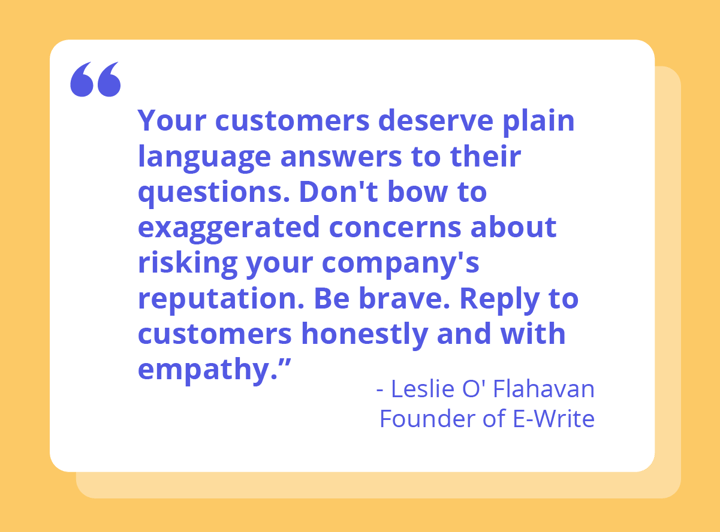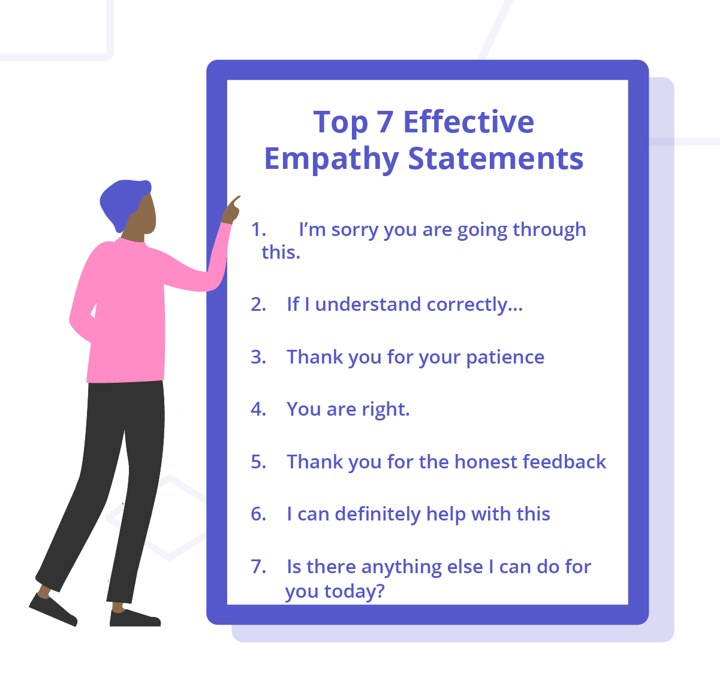Top 7 Effective Empathy Statements in Customer Service

Empathy statements in customer service can calm agitated callers and create a platform upon which to build a way forward to a resolution. Magic words that build trust and let the customer know they can expect to have their problem solved.
Whether it lasts 15 seconds or five minutes, a relationship develops between the customer and call center agent. It’s transactional, to be sure, with the caller wanting something from the agent and having a preconceived idea of what it will take to determine whether the relationship was satisfactory or not. Responsibility falls on the agent to pivot as necessary. But the one thing sure to soften the hardest incoming heart is the agent’s use of empathy.
Building upon Procedureflow ’s comprehensive article on empathy, we’ll now look at the top 7 effective empathy statements in customer service, why they improve customer satisfaction (CSAT) , and how to use them.

What is good customer service empathy?
There was a time when being friendly was almost enough to deliver acceptable customer service. Customers had fewer options and didn’t feel as empowered to leave a company because of an unsatisfactory experience. However, those simpler times also came with rotary telephones tethered to walls and no Internet. Things have changed.
Friendliness is important. But in customer service, empathy is crucial.
A call center agent demonstrates empathy by intentionally putting themselves in the customer’s shoes and appreciating what the customer feels. It’s the result of listening to them, understanding the impact the situation is having, and showing compassion for what they’re going through. The reason for their call is the most important thing in their life at that moment. An empathetic agent not only gets that, but they also prove it to the customer.
It’s tempting, but dangerous, to believe that a lack of complaints equals customer satisfaction. You’re familiar with “quiet quitting”? It’s not just for employment. According to an article by HuffPost , only 4% of unsatisfied customers will bother to complain about their experience. They’ll simply churn. However, even though they don’t tell you they were unsatisfied, they will tell their friends.
“Companies should not view absence of feedback as a sign of satisfaction. The true enemy is indifference.”
~Esteban Kolsky, founder, ThinkJar
What is an example of an empathy statement in customer service?
The thesaurus is wrong. Empathy and sympathy are not interchangeable. Sympathy is feeling sorry for someone or their situation, sometimes with a sense of relief that you’re not in their shoes. Sympathy can create a wedge between people as one takes pity on the other’s plight. Empathy brings people closer as they share a sense of reality.
In therapy, a technique called parroting is highly effective in demonstrating empathy. Once the client explains a situation, the therapist paraphrases it back to them. This accomplishes two things. It demonstrates to the client that they’re being heard. And it allows them to correct any mistakes the therapist makes in their understanding of the situation, and for them to further clarify what they’ve said.
In a call center, repeating back what the caller has said lets them know that the agent is in the situation with them. Begin the sentence with, “If I understand correctly…”, and ask them to confirm. “Do I have that right?”
Thanks to software solutions like Procedureflow, customer service organizations can make it simple for agents to improve CSAT scores by implementing empathy statements into their visual call flows and scripting. No downtime, no hesitation, just better CX.
Being more effective leads to better job satisfaction for agents, too. With employee retention a constant challenge, nurturing empathy means everybody wins.
Related Resource: Empathy in Customer Service: What it Means and How to Implement It
How do you deliver empathy statements in customer service?
The most important factor in determining when to deliver empathy statements in customer service, is to listen to the customer for cues.
If they are irate, you can attempt to calm them down.
If they are confused, you can assure them that you will be with them all the way to sort out the issue.
If they feel abandoned, you can let them know that their problem is of the utmost importance to you.
Often, an empathy statement is delivered as a transition to a next step in extracting information or working toward a resolution.
“Thanks for being so patient today. Please give me your client number and ….”
Speaking one to one creates a bond between the agent and client. Use “I” instead of “we” statements. People want to feel that they’re dealing with another human being. The empathy statements in customer service must appear genuine. Delivered with real, human feelings. While a “I understand your concern,” may appear to be empathetic, this generic statement actually seems cold and detached compared to authentic expressions of empathy.
And advise agents to refrain from chiming in with their own, similar experience. Although they might intend to create a rapport, the customer might feel the agent doesn’t truly get it. It’s best to stick with language that shows an understanding of the client’s feelings and leave themselves out of it.
Top 7 empathy statements in customer service
Here are the top 7 empathy statements in customer service that demonstrate an understanding of the situation and genuine appreciation for what the client is experiencing.
- “I’m sorry you are going through this.” Whatever it is, the customer wishes it wasn’t happening. This statement proves that the agent understands this and is on their side. It also includes the important words, I’m sorry.
- “If I understand correctly …” This statement is part of the parroting technique mentioned earlier. Repeating the customers words back to them offers reassurance and validates their concerns
- “Thank you for your patience.” Everyone’s time is valuable. Whether or not there have been repeat calls or the client has been on hold, acknowledge the use of their time.
- “You are right.” Three little words that act like a release valve in a hot situation. You are right that it’s supposed to work this way. You are right that this should have been resolved sooner. You are right that the wording wasn’t clear.
- “Thank you for the honest feedback.” Expressing gratitude for feedback, positive or negative, recognizes that it’s not always easy to express oneself.
- “I can definitely help with this.” Exuding confidence in the situation bolsters the customer’s faith that the agent will follow through until there’s a resolution.
- “Is there anything else I can do for you today?” No matter the length of the call or its complications, this statement leaves the customer feeling like there’s nothing more important than making sure they’re completely satisfied.

Empathy statements in customer service are much more than mere words. They’re the gateway to developing and using genuine empathy to get inside a customer’s head and figure out what they need. A sense of empathy makes a person a good friend, a great partner, and a caring family member. And it’s clear that it’s just as important to develop empathy for effective customer service.
To find out how Procedureflow can help your employees reach proficiency faster, book a demo today


